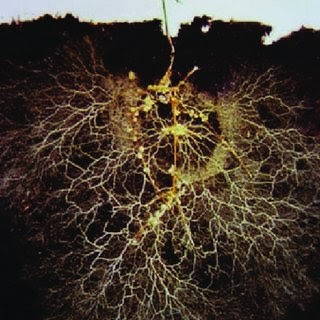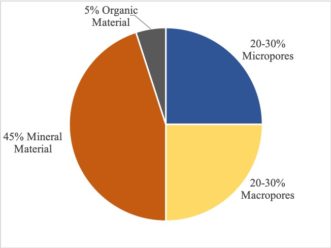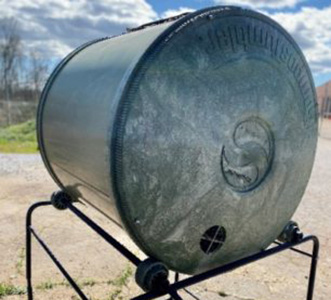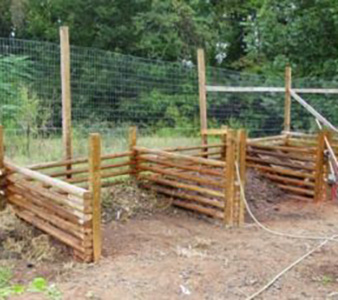Soil biodiversity is key to a botanical garden’s success. The benefits of soil biodiversity include mitigating harmful pathogens and soil compaction, as well as increasing available nutrients and improving soil structure. This article discusses the importance of soil biodiversity and provides management strategies for managerial staff of botanical gardens (public gardens, parks, larger private botanical gardens) to improve soil biodiversity throughout the garden.
The Importance of Soil Biodiversity
Common sense holds that healthy soils help grow healthy plants. But what is healthy soil? The answer is complex. Soil biodiversity, or the variety of life forms present in the soil, is an essential element that affects many other aspects of soil health. Soil is teeming with life. For example, the combined number of described species of soil-dwelling nematodes and mites is over 35,000.1 Given that nematodes and mites are just two of several types of soil organisms, it is not a surprise that soil biology influences the plants growing there. Although some soil organisms cause disease or damage to the plant roots, there are a vast number of organisms that form mutually beneficial relationships with plants.
What Can Soil Organisms Do for You

Figure 1. Mycorrhizal fungi form a symbiotic relationship with plant roots, helping them take up more water and nutrients. Image credit: Professor Sir David Reed, Clemson University.
Mycorrhizal fungi are an example of beneficial soil organisms. Mycorrhizal symbioses are found in over 90% of all terrestrial plant species.2 Mycorrhizal fungi form a symbiotic relationship with plant roots that increases water and nutrient uptake beyond what the roots could do on their own. In effect, mycorrhizal fungi extend the plant root network deeper into the soil (figure 1). In exchange, the mycorrhizae obtain sugars from the plant. Mycorrhizal networks can also, in the right conditions, enhance seedling establishment and nutrient cycling.3 Detritivores, including insects, fungi, earthworms, and bacteria, are another example of beneficial soil organisms. Detritivores break down dead plant material, thus helping to make nutrients available to the living plants and other organisms. Mycorrhizae and bacteria are responsible for up to 80% of the plant-available nitrogen and up to 75% of the plant-available phosphorus found in soils.4 Additionally, earthworms and other soil organisms improve soil structure for plants by decreasing compaction and releasing a sticky microbial glue that binds soil particles, thus improving soil aggregation. Increased soil aggregation improves soil porosity, resulting in improved water retention, drainage, nutrient retention, and air movement. These beneficial soil properties aid in root growth. Soil organisms also help improve soil health by breaking down residual pesticides and other contaminants present in the soil, further protecting plants and other organisms.5
Soil Organisms as Plant Guardians
Naturally, not all soil organisms are beneficial to plants. Quite a few pathogens, such as Pythium and Rhizoctonia, and herbivores live in the soil. Fortunately, some soil organisms can help defend plants from their detrimental counterparts. Some microorganisms in the rhizosphere, the area directly influenced by plant roots, combat plant pathogens directly through antibiosis, in which one organism attacks another, or parasitism, in which one organism feeds on another, harming and, often, eventually killing it. For example, fungi belonging to the genus Trichoderma produce antimicrobial compounds in abundance.6 Additionally, biodiversity within soils enhances competition among pathogenic and beneficial soil organisms for nutrients and microsites. Some microorganisms interfere with how a pathogen responds to the environment, disrupting its ability to express disease. Finally, some soil organisms induce an immune response in the plant (called induced systemic resistance) that helps the plant to more effectively fight off the pathogen.6
Diversity Promotes Diversity
A variety of research has proven that plants affect soil and the organisms that live within. For example, studies show that removing or manipulating plant groups in grasslands reduces the abundance and diversity of soil organisms there.7 In a UK study, mite communities in the more plant-diverse birch woodlands had a greater species richness than mite communities in less plant-diverse heather moorlands.8 Diverse plant species release different chemicals that influence soil biology through decomposing tissues and root exudates. The chemicals released by varied tree species affect the composition of mite communities in the soil.1 The diversity of plants typically growing in botanical gardens provides the potential for greater soil biodiversity than other managed lands.
Increasing Soil Biology
Increasing soil biodiversity should be part of a comprehensive soil management plan, given its many benefits. Three approaches to enhancing soil biodiversity within a botanical garden setting are discussed below.
Creating Optimal Soil Conditions
Soil conditions determine the success of soil organisms as well as the diversity of plant communities. Optimal soil conditions for both plants and soil organisms generally consists of 5% organic matter, 45% mineral materials, between 20% and 30% macropores for draining and venting, and between 20% and 30% micropores for holding water by volume (figure 2).9 A thriving soil community helps to maintain this balance as diverse soil organisms contribute to the various beneficial characteristics and processes of soil.
Organic matter feeds soil organisms. In turn, soil organisms release simplified forms of nutrients more readily available to plants and other organisms for use in day-to-day processes. Organic matter also influences how soils retain and drain water, and how much of the retained water is available to plants. Water present in the soil is essential to creating the humid environment necessary for many organisms (such as earthworms) and microfauna living in thin water films covering soil particles.10 Many of South Carolina’s soils lack adequate organic matter. Increasing and maintaining organic matter (e.g., by adding compost) allows a variety of organisms within South Carolina’s botanical garden soils to thrive.
Diversify
Diverse plant species promote biodiversity because they support different microorganisms (and vice versa).11 Therefore, a diverse collection of plants helps to achieve greater soil biodiversity. Botanical gardens strive to display a vast collection of plants, which consequently promotes soil biodiversity. However, the same plant species growing in a single area over time can lead to the depletion of soil nutrients necessary to sustain soil biodiversity. In responsible agricultural production, crop rotation serves to replenish nutrients and maintain a dynamic soil ecosystem. Introducing soil biology from different areas of the botanical gardens (e.g., by mixing soil from different planting beds) can encourage diversity and increase subsequent benefits. A list of beds that have harmful organisms that have previously been problematic should be maintained. Consult the list to exclude mixing the soil from these beds into other beds as well as incorporating plant debris from these beds into compost.
Management Practices Currently in Use
Many botanical gardens currently include practices to promote soil biodiversity in their regular maintenance, though these practices may be unintentional. A simple example would be how most botanical gardens curate impressive collections of diverse plants grown relatively close together. This practice promotes soil biodiversity by creating soil environments suitable for a variety of organisms. Different styles of root systems (e.g., shallow vs. deep-rooted and coarse vs. fine roots) create varied habitats for soil organisms. For example, researchers in New Mexico found most nematodes at depths that were quite different near creosote bushes compared to mesquite.1 Amendment of planting beds with organic matter and addition of mulch are also excellent practices that promote soil biodiversity.
Improving the Soil through Compost
Soil organic matter is critical to plant health, as it improves water retention, provides nutrients for plants and soil organisms, and improves the soil structure.12 Organic matter removal (e.g., by plant removal and soil compaction) decreases the abundance and species richness of multiple groups of soil organisms.13 Compost application, whether made on-site or obtained from an outside source, is perhaps the easiest way to increase organic matter in the soil. Composting is cost-effective because it requires minimal equipment such as the compost tumbler (figure 3) or wooden box (figure 4) and can reduce the cost of fertilizers since it adds vital plant nutrients to the soil. Botanical gardens using compost created by mixing decayed plant material and microorganisms from various locations in the garden can reap the soil health benefits of distributing this mixture, abundant in soil biodiversity, throughout the garden. As previously discussed, it is important to have and consult a list of beds and plant materials that have had problematic organisms. Plant material and soils affected should not be composted. Compost application is practical in many gardens and highly beneficial to soil biodiversity, and thus to soil health.
Protecting the Soil with Mulch
Mulch application is another management practice used in botanical gardens that provides multiple soil health benefits. While it is well-known that mulching aids in water retention, maintaining soil temperature, and weed suppression, from a soil biodiversity standpoint, mulching is also crucial in protecting the soil from compaction.14 Mulching can increase aeration and oxygen diffusion in the soil.15 Soil compaction is a particular concern in botanical gardens due to heavy visitor foot traffic. Low densities of soil organisms are linked to areas with heavy soil compaction.13
Many types of mulch are available, both organic and inorganic based. Organic mulches (e.g., wood chips or pine straw) not only maintain soil moisture and temperature and suppress weeds but also add organic matter into the soil as they break down. However, they need to be replenished about every two to four years (depending on mulch thickness applied). Mulches should be applied after planting whenever possible, to best protect the soil from moisture loss and subsequently encourage soil microbial activity.
Recommended Management Practices
Botanical gardens can improve soil health by encouraging soil biodiversity through simple, cost-effective management practices.
Mixing Soils to Establish Preferred Soil Biology
Botanical gardens have a diversity of plants growing throughout their established beds. Each plant has a unique rhizosphere full of soil organisms optimal for its growth. When a new plant species or planting bed is introduced to the garden or a new bed is installed, the established soil biology may not be appropriate for the new planting. The root hairs or fibrous roots of plants establishing new rooting systems release signals to attract certain microbes to their new rhizosphere.16 Incorporate soil collected and mixed from various established planting beds into the rootzone mix for new beds. Adding this mixture may help to increase soil biodiversity and assist new plant establishment. One study that demonstrated how this could work showed that mixing decomposing plant litter (which represents a large portion of the organic matter in the top layers of soil) from different species led to an increase in both microbial biomass and microbial diversity.17 As previously advised under the “Diversify” section, do not utilize soils from beds that have harmful organisms that have previously been problematic. Incorporating these soils into healthy soils could cause similar problems.
Decreasing Traffic and Preventing Compaction
Soil compaction damages soil structure and leads to a decrease in porosity or a shift in pore size from macropores to more micropores. Remember, macropores and micropores are in roughly equal proportions in healthy soils (figure 2). The elimination or imbalance of pore space causes a domino effect of problems as water, nutrient, and air exchange are diminished, they also become less available to plants and soil organisms. The soil’s weight, foot, and vehicular traffic, as well as the pounding of rain and irrigation water on the soil surface, causes soil compaction.9 Mulching helps to reduce soil compaction caused by rain and irrigation water. To mitigate soil compaction by foot traffic, educate employees and visitors about the importance of staying on established paths and walkways. Create educational signs and amend informational pamphlets to explain the detrimental impact of soil compaction caused by foot traffic on soil biology and plant health. Consider additional signage encouraging visitors to stay on paths and keep out of beds, particularly in areas where visitors are prone to straying off the path. Temporary or permanent barriers may serve as visual reminders, helping visitors remain on designated walkways.
Creating Optimal pH Conditions for Biological Activity
Soil pH influences the activity of many soil organisms. Most plants and soil organisms thrive in a pH between 5.5 to 7.0.9 Amending the soil to help maintain an optimal pH for microbial activity can provide benefits for plants and soil structure throughout the garden. Determine soil pH by having a soil sample tested by an agricultural laboratory such as Clemson University’s Agricultural Service Laboratory. When the pH is outside of the optimal range, soil amendments, such as sulfur or limestone, may be necessary to correct the imbalance. A soil test report provides recommendations for the appropriate amendment, as well as the recommended rate. It is imperative to follow soil test recommendations as over application is equally detrimental. By maintaining an optimal pH, botanical gardens may better reap the benefits of soil biodiversity.
Conclusion
Soil biodiversity is essential to establishing healthy plant communities within a botanical garden. Having a healthy soil microbial community also helps to mitigate the harmful effects of pathogens and soil compaction, while also increasing nutrient availability and improving soil structure. Strategies to improve soil biodiversity in botanical gardens include adding compost, mulching, mixing soil from different locations in the garden, preventing soil compaction, and managing the soil pH.
References Cited
- Sylvain ZA, Wall DH. Linking soil biodiversity and vegetation: Implications for a changing planet. American Journal of Botany. 2011;98(3):517–527. doi:10.3732/ajb.1000305.
- Feijen F, Vos R, Nuytinck J, Merckx V. Evolutionary dynamics of mycorrhizal symbiosis in land plant diversification. Scientific Reports. 2018 [accessed 2020 March 6]. https://www.ncbi.nlm.nih.gov/pmc/articles/PMC6048063/.
- Thiele-Bruhn S, Bloem J, DeVries F, Kalbitz K, Wagg C. Linking soil biodiversity and agricultural soil management. Current Opinion in Environmental Sustainability. 2012 [accessed 2020 Mar 6];4(5):523–528. doi:10.1016/j.cosust.2012.06.004.
- van der Heijden MGA, Bardgett RD, van Straalen NM. The unseen majority: soil microbes as drivers of plant diversity and productivity in terrestrial ecosystems. Ecology Letters. 2008;11(3):296-310. doi:10.1111/j.1461-0248.2007.01139.x.
- Lehman MR, Acosta-Martinez V, Buyer J, Cambardella CA, Collins H, Ducey T, Halvorson JJ, Jin VL, Johnson JMF, Kremer RJ, Lundgren JG, DK Manter, Maul JE, Smith JL, Stott DE. Soil biology for resilient, healthy soil. Soil and Water Conservation Society. 2015;70(1):12A–18A. doi:10.2489/jswc.70.1.12A.
- Mendes R, Garbeva P, Raaijmakers JM. Rhizosphere microbiome: significance of plant beneficial, plant pathogenic, and human pathogenic microorganisms. FEMS Microbiology Reviews. 2013;37(5):634–663. doi:10.1111/1574-6976.12028.
- Wardle DA, Bonner KI, Barker GM, Yeates GW, Nicholson KS, Bardgett RD, Watson RN, Ghani A. Plant removals in perennial grassland: vegetation dynamics, decomposers, soil biodiversity, and ecosystem properties. Ecological Monographs. 1999;69(4):535–568. doi:10.2307/2657230.
- Nielsen UN, Osler GHR, Burslem DFRP, Wal Rvan der, Campbell CD. The influence of vegetation type, soil properties and precipitation on the composition of soil mite and microbial communities at the landscape scale. Journal of Biogeography. 2010;37(7):1317–1328. doi:10.1111/j.1365-2699.2010.02281.x
- Weil RR, Brady NC. The nature and properties of soils. 15th ed. Columbus (OH): Pearson; 2016.
- Bot A, Benites J. The importance of soil organic matter, key to drought-resistant soil and sustained food production. Rome (Italy): Food and Agriculture Organization of the United Nations. 2005 [accessed 2020 March 22]. http://www.fao.org/3/a-a0100e.pdf.
- Ortiz-Castro R, Contreras-Cornejo HA, Macias-Rodriguez L, Lopez-Bucio J. The role of microbial signals in plant growth and development. Plant Signaling & Behavior. 2009 [accessed 2020 March 22];4(8):701–712. doi:10.4161/psb.4.8.9047.
- Mylavarapu R, Zinati G. Improvement of soil properties using compost for optimum parsley production in sandy soils. Scientia Horticulturae. 2009 [accessed 2020 Mar 21];120(3):426–430. doi:10.1016/j.scienta.2008.11.038.
- Battigelli JP, Berch SM, Spence JR, Langor DW. Short-term impact of forest soil compaction and organic matter removal on soil mesofauna density and oribatid mite diversity. Canadian Journal of Forest Research. 2004 [accessed 2020 Mar 3];34(5):1136–1149. doi:10.1139/x03-267.
- Ramakrishna A, Tam HM, Wani SP, Long TD. Effect of mulch on soil temperature, moisture, weed infestation and yield of groundnut in northern Vietnam. Field Crops Research. 2006 [accessed 2020 Mar 21];95(2-3):115–125.. doi:10.1016/j.fcr.2005.01.030.
- Khan AR, Chandra D, Quraishi S, Sinha RK. Soil aeration under different soil surface conditions. Journal of Agronomy and Crop Science. 2000 [accessed 2020 Mar 21];185(2):105–112. doi:10.1046/j.1439-037X.2000.00417.x.
- Nihorimbere V, Ongena M, Smargiassi M, Thonart P. Beneficial effect of the rhizosphere microbial community for plant growth and health. Biotechnology, Agronomy, Society and Environment. 2011 [accessed 2020 Mar 7];15(2): 327–337. https://popups.uliege.be:443/1780-4507/index.php?id=7578.
- Chapman S, Newman G. Biodiversity at the plant-soil interface: microbial abundance and community structure respond to litter mixing. Oecologia. 2010;162:763–769. doi:10.1007/s00442-009-1498-3.




